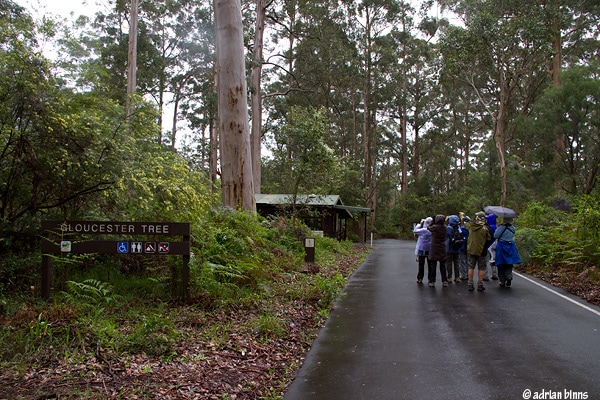AUSTRALIA: WESTERN AUSTRALIA, Pemberton to Cheyne’s Beach
Nov 11, 2012 | by Adrian Binns
Oct 3: Our birding tour of Western Australia continued on a morning with on-off showers, the first precipitation encountered in several weeks. Undeterred, we explored the roads and trails of Gloucester Tree, a Karri Forest preserve not far from our hotel, featuring towering 90m eucalyptus, native to this region of Western Australia.
We found plenty to hold our interest in an hour’s birding, including White-breasted Robin, Grey Fantail, White-browed Scrubwren and a Fan-tailed Cuckoo posing nicely. For the first time, we encountered the striking Spotted Pardalote, a small foliage gleaning insectivore. We delighted in watching a Swamp River Honeyeater (recently split from White-naped Honeyeater), which unlike most other members of its family, behaves like a treecreeper or nuthatch. For fun, Barry climbed a few of the spiraling pin steps that make up the 70-meter climb to the crown of a marked Gloucester Tree. There was a lovely moment when a Brush Bronzewing (a ground dwelling dove), Western Rosella, Grey Shrikethrush and a Ring-necked Parrot (whose old name was “twenty-eight parrot”, after its call, though really it sounds more like 28 in French!), converged around us on the ground, seemingly oblivious to our presence, as we were walking back to the bus.
We left the preserve and moved on to Big Broom Dam, where we got our first looks at one of Australia’s smallest birds, as well as the largest. We saw a party of Red-winged Fairy Wrens, beautiful, tiny insect-eaters, foraging through the undergrowth. And we encountered the ostrich-like Emu with seven chicks in tow; the adult made sure to position herself between us and her youngsters, to protect them as she led them away.
Wandering around Lake Muir Observatory, we admired the fauna, including Patersoni Iris and Spider Orchids, while getting good views of Pallid Cuckoo and Striated Pardalote, cousin of the Spotted Pardalote we saw earlier, while we were eating our picnic lunch.
Along Frankland Road in Rocky Gully, we were fortunate enough to locate three Western Corella, an increasingly rare cockatoo species. Small flocks of Little Crows outnumbered their larger more vocal relatives, the Australian Crow. We watched a flock of Baudin’s Black Cockatoos feeding on Marri fruit, noting that they are all left-footed, using that appendage to hold down their favorite food while eating. Along the edge of green pastures we found a few Yellow-rumped Thornbills feeding in short grass. Passing through a village, we pulled over to look at a Red-capped Parrot that was at a feeder.
We stopped in the small town of Albany for supplies, then drove 65km east to Cheyne’s Beach, a remote outpost on the southern coast of Australia where we would spend two nights. At the Cheyne’s Beach Caravan Park, we checked into our comfortable chalets, tucked into a home-cooked dinner, and retired early in preparation for a full day in the area the following day.
all photos © adrian binns

































